HR Risk Management Report: Analysis of Woolworths Limited Operations
VerifiedAdded on 2020/07/23
|15
|3973
|96
Report
AI Summary
This report provides a comprehensive analysis of human resources risk management within Woolworths Limited. It begins by outlining the importance of risk management processes and their scope, referencing the need for ethical conduct and compliance with regulations. The report delves into the identification of internal and external stakeholders, detailing their roles and the risks associated with each. It then explores the specific risks faced by Woolworths, including political, economic, social, technological, legal, and environmental factors, alongside their respective strengths and weaknesses in managing these risks. Key success factors and objectives for a risk management plan are presented, followed by an examination of tools, techniques, and a risk assessment matrix. The report concludes with a discussion on prioritizing risk treatments, developing action plans, documentation requirements, and the implementation and monitoring of the risk management process, including available insurance options. The analysis provides a detailed overview of risk management strategies and their practical application within the context of a large retail organization.
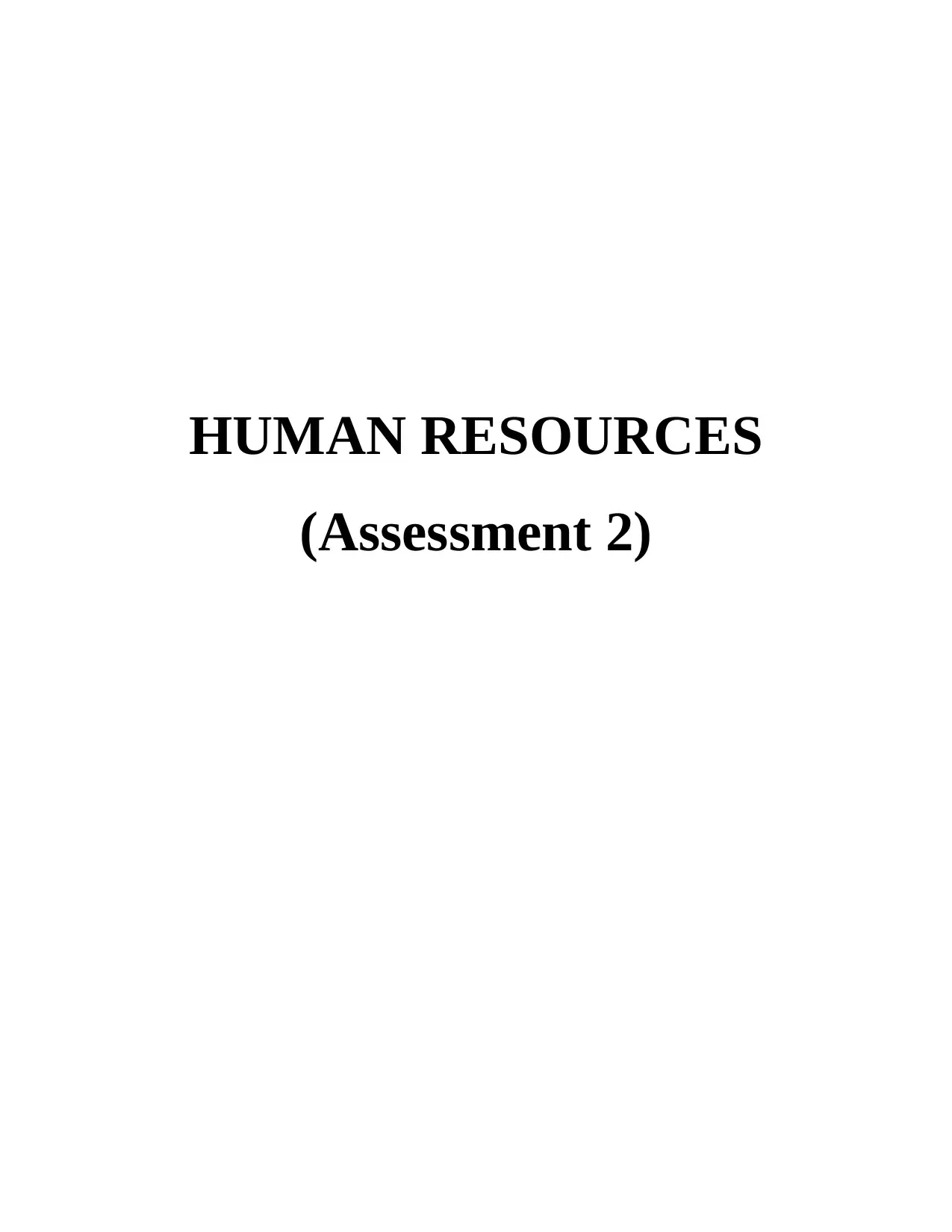
HUMAN RESOURCES
(Assessment 2)
(Assessment 2)
Paraphrase This Document
Need a fresh take? Get an instant paraphrase of this document with our AI Paraphraser
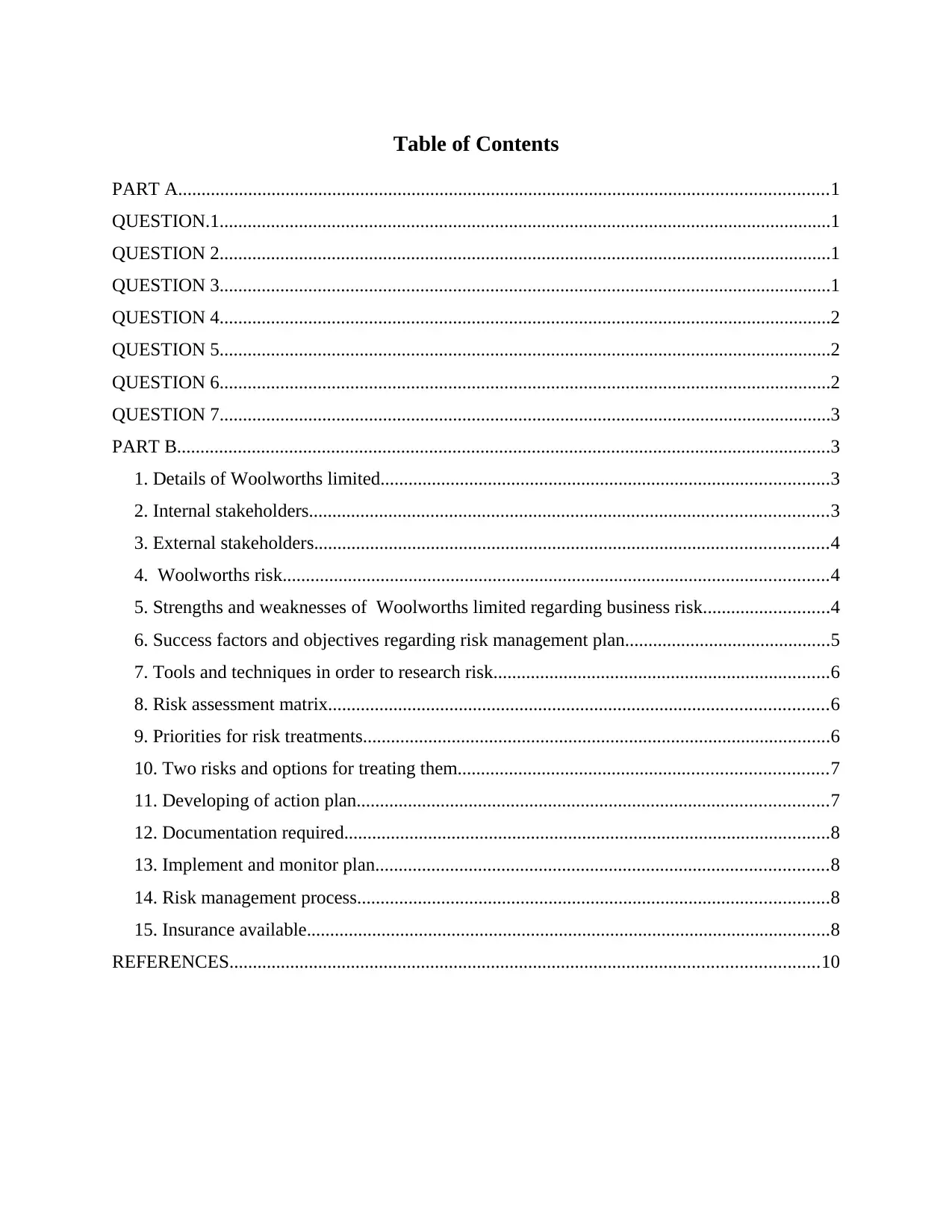
Table of Contents
PART A...........................................................................................................................................1
QUESTION.1...................................................................................................................................1
QUESTION 2...................................................................................................................................1
QUESTION 3...................................................................................................................................1
QUESTION 4...................................................................................................................................2
QUESTION 5...................................................................................................................................2
QUESTION 6...................................................................................................................................2
QUESTION 7...................................................................................................................................3
PART B............................................................................................................................................3
1. Details of Woolworths limited................................................................................................3
2. Internal stakeholders...............................................................................................................3
3. External stakeholders..............................................................................................................4
4. Woolworths risk.....................................................................................................................4
5. Strengths and weaknesses of Woolworths limited regarding business risk...........................4
6. Success factors and objectives regarding risk management plan............................................5
7. Tools and techniques in order to research risk........................................................................6
8. Risk assessment matrix...........................................................................................................6
9. Priorities for risk treatments....................................................................................................6
10. Two risks and options for treating them...............................................................................7
11. Developing of action plan.....................................................................................................7
12. Documentation required........................................................................................................8
13. Implement and monitor plan.................................................................................................8
14. Risk management process.....................................................................................................8
15. Insurance available................................................................................................................8
REFERENCES..............................................................................................................................10
PART A...........................................................................................................................................1
QUESTION.1...................................................................................................................................1
QUESTION 2...................................................................................................................................1
QUESTION 3...................................................................................................................................1
QUESTION 4...................................................................................................................................2
QUESTION 5...................................................................................................................................2
QUESTION 6...................................................................................................................................2
QUESTION 7...................................................................................................................................3
PART B............................................................................................................................................3
1. Details of Woolworths limited................................................................................................3
2. Internal stakeholders...............................................................................................................3
3. External stakeholders..............................................................................................................4
4. Woolworths risk.....................................................................................................................4
5. Strengths and weaknesses of Woolworths limited regarding business risk...........................4
6. Success factors and objectives regarding risk management plan............................................5
7. Tools and techniques in order to research risk........................................................................6
8. Risk assessment matrix...........................................................................................................6
9. Priorities for risk treatments....................................................................................................6
10. Two risks and options for treating them...............................................................................7
11. Developing of action plan.....................................................................................................7
12. Documentation required........................................................................................................8
13. Implement and monitor plan.................................................................................................8
14. Risk management process.....................................................................................................8
15. Insurance available................................................................................................................8
REFERENCES..............................................................................................................................10
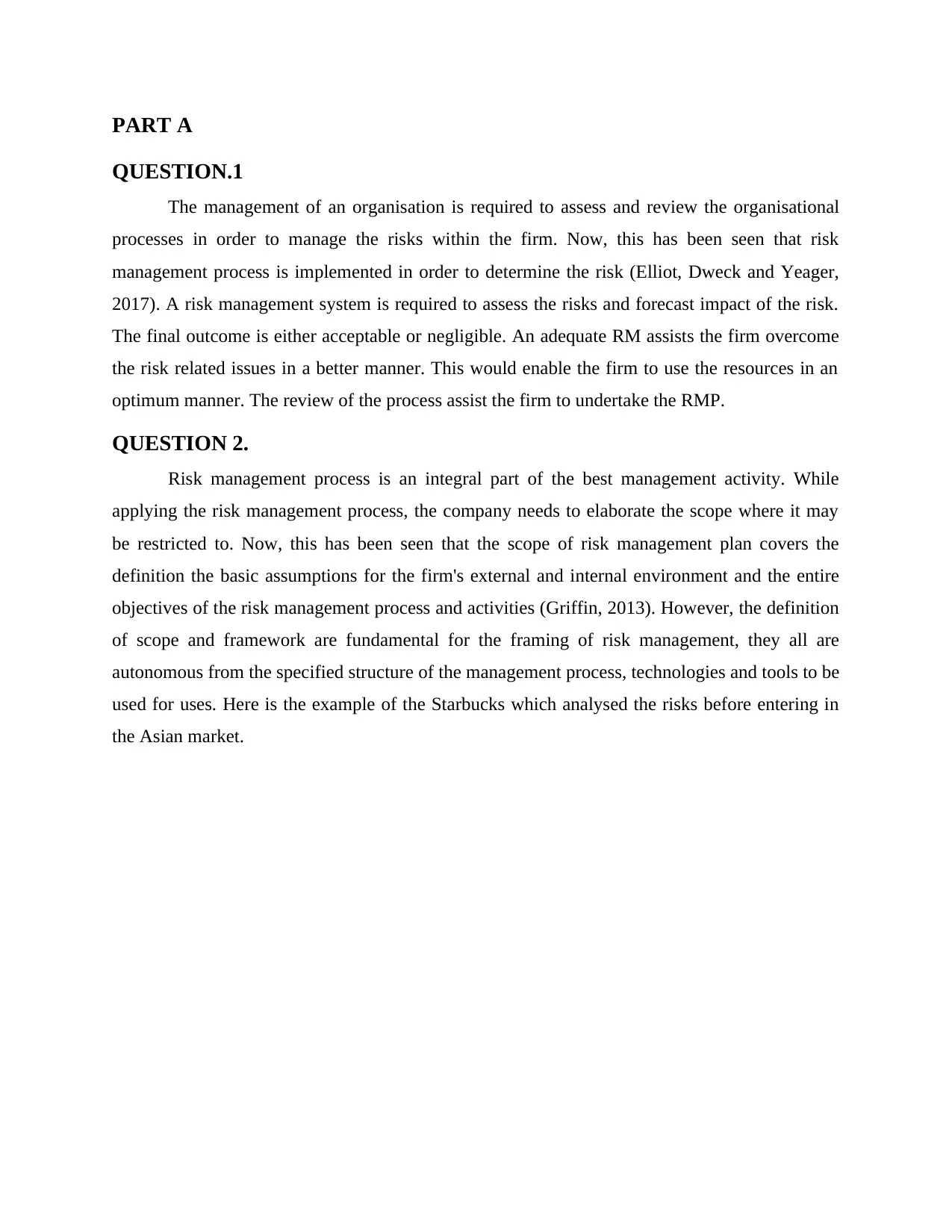
PART A
QUESTION.1
The management of an organisation is required to assess and review the organisational
processes in order to manage the risks within the firm. Now, this has been seen that risk
management process is implemented in order to determine the risk (Elliot, Dweck and Yeager,
2017). A risk management system is required to assess the risks and forecast impact of the risk.
The final outcome is either acceptable or negligible. An adequate RM assists the firm overcome
the risk related issues in a better manner. This would enable the firm to use the resources in an
optimum manner. The review of the process assist the firm to undertake the RMP.
QUESTION 2.
Risk management process is an integral part of the best management activity. While
applying the risk management process, the company needs to elaborate the scope where it may
be restricted to. Now, this has been seen that the scope of risk management plan covers the
definition the basic assumptions for the firm's external and internal environment and the entire
objectives of the risk management process and activities (Griffin, 2013). However, the definition
of scope and framework are fundamental for the framing of risk management, they all are
autonomous from the specified structure of the management process, technologies and tools to be
used for uses. Here is the example of the Starbucks which analysed the risks before entering in
the Asian market.
QUESTION.1
The management of an organisation is required to assess and review the organisational
processes in order to manage the risks within the firm. Now, this has been seen that risk
management process is implemented in order to determine the risk (Elliot, Dweck and Yeager,
2017). A risk management system is required to assess the risks and forecast impact of the risk.
The final outcome is either acceptable or negligible. An adequate RM assists the firm overcome
the risk related issues in a better manner. This would enable the firm to use the resources in an
optimum manner. The review of the process assist the firm to undertake the RMP.
QUESTION 2.
Risk management process is an integral part of the best management activity. While
applying the risk management process, the company needs to elaborate the scope where it may
be restricted to. Now, this has been seen that the scope of risk management plan covers the
definition the basic assumptions for the firm's external and internal environment and the entire
objectives of the risk management process and activities (Griffin, 2013). However, the definition
of scope and framework are fundamental for the framing of risk management, they all are
autonomous from the specified structure of the management process, technologies and tools to be
used for uses. Here is the example of the Starbucks which analysed the risks before entering in
the Asian market.
⊘ This is a preview!⊘
Do you want full access?
Subscribe today to unlock all pages.

Trusted by 1+ million students worldwide
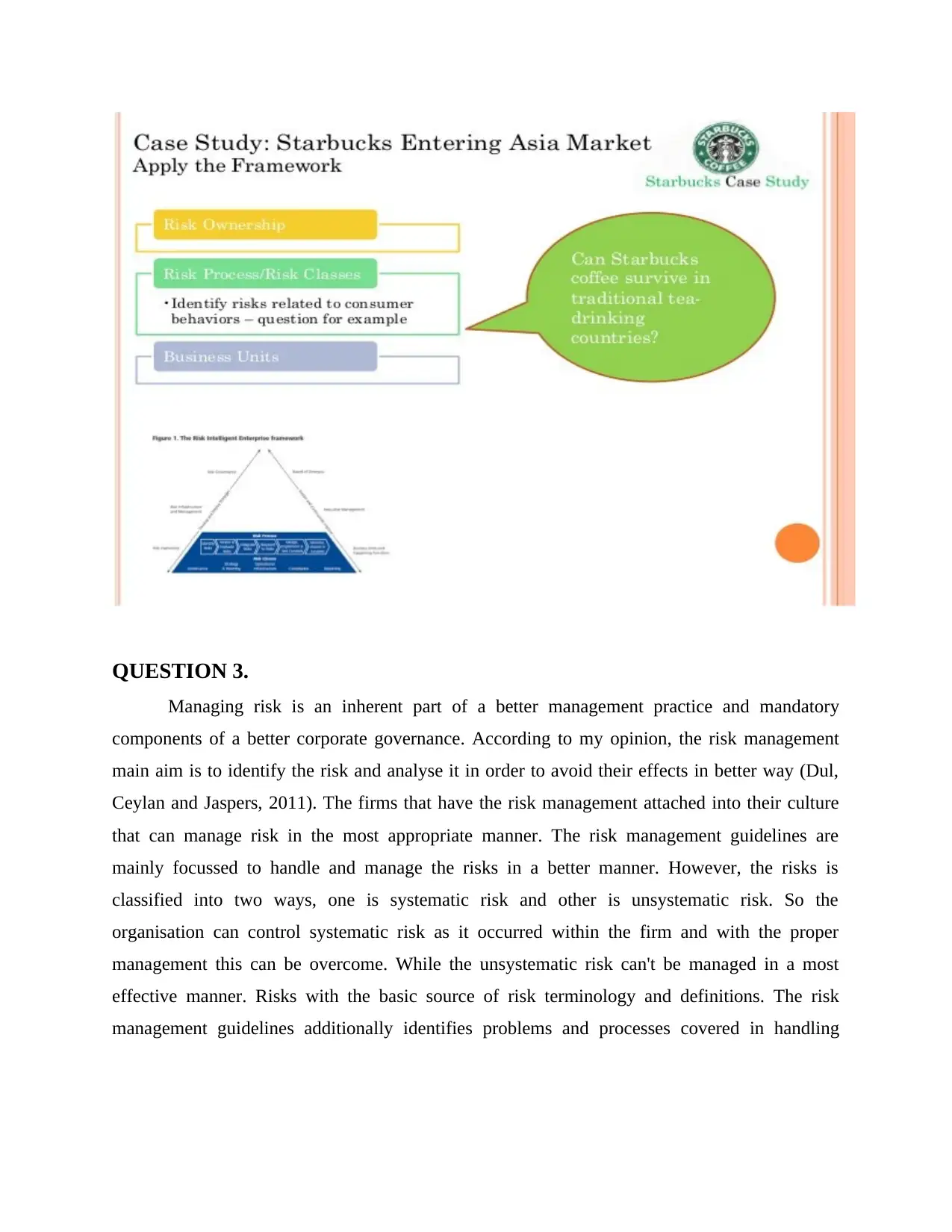
QUESTION 3.
Managing risk is an inherent part of a better management practice and mandatory
components of a better corporate governance. According to my opinion, the risk management
main aim is to identify the risk and analyse it in order to avoid their effects in better way (Dul,
Ceylan and Jaspers, 2011). The firms that have the risk management attached into their culture
that can manage risk in the most appropriate manner. The risk management guidelines are
mainly focussed to handle and manage the risks in a better manner. However, the risks is
classified into two ways, one is systematic risk and other is unsystematic risk. So the
organisation can control systematic risk as it occurred within the firm and with the proper
management this can be overcome. While the unsystematic risk can't be managed in a most
effective manner. Risks with the basic source of risk terminology and definitions. The risk
management guidelines additionally identifies problems and processes covered in handling
Managing risk is an inherent part of a better management practice and mandatory
components of a better corporate governance. According to my opinion, the risk management
main aim is to identify the risk and analyse it in order to avoid their effects in better way (Dul,
Ceylan and Jaspers, 2011). The firms that have the risk management attached into their culture
that can manage risk in the most appropriate manner. The risk management guidelines are
mainly focussed to handle and manage the risks in a better manner. However, the risks is
classified into two ways, one is systematic risk and other is unsystematic risk. So the
organisation can control systematic risk as it occurred within the firm and with the proper
management this can be overcome. While the unsystematic risk can't be managed in a most
effective manner. Risks with the basic source of risk terminology and definitions. The risk
management guidelines additionally identifies problems and processes covered in handling
Paraphrase This Document
Need a fresh take? Get an instant paraphrase of this document with our AI Paraphraser
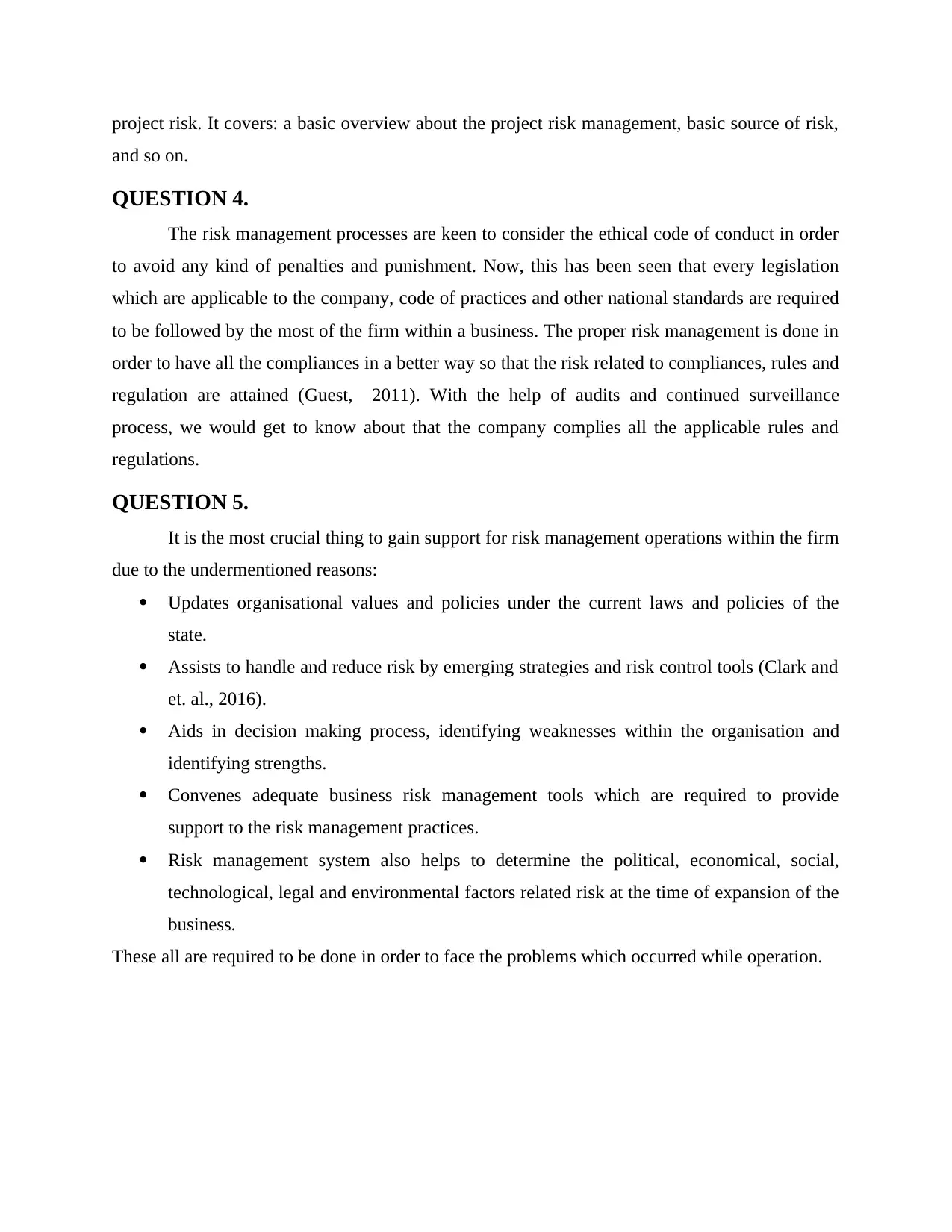
project risk. It covers: a basic overview about the project risk management, basic source of risk,
and so on.
QUESTION 4.
The risk management processes are keen to consider the ethical code of conduct in order
to avoid any kind of penalties and punishment. Now, this has been seen that every legislation
which are applicable to the company, code of practices and other national standards are required
to be followed by the most of the firm within a business. The proper risk management is done in
order to have all the compliances in a better way so that the risk related to compliances, rules and
regulation are attained (Guest, 2011). With the help of audits and continued surveillance
process, we would get to know about that the company complies all the applicable rules and
regulations.
QUESTION 5.
It is the most crucial thing to gain support for risk management operations within the firm
due to the undermentioned reasons:
Updates organisational values and policies under the current laws and policies of the
state.
Assists to handle and reduce risk by emerging strategies and risk control tools (Clark and
et. al., 2016).
Aids in decision making process, identifying weaknesses within the organisation and
identifying strengths.
Convenes adequate business risk management tools which are required to provide
support to the risk management practices.
Risk management system also helps to determine the political, economical, social,
technological, legal and environmental factors related risk at the time of expansion of the
business.
These all are required to be done in order to face the problems which occurred while operation.
and so on.
QUESTION 4.
The risk management processes are keen to consider the ethical code of conduct in order
to avoid any kind of penalties and punishment. Now, this has been seen that every legislation
which are applicable to the company, code of practices and other national standards are required
to be followed by the most of the firm within a business. The proper risk management is done in
order to have all the compliances in a better way so that the risk related to compliances, rules and
regulation are attained (Guest, 2011). With the help of audits and continued surveillance
process, we would get to know about that the company complies all the applicable rules and
regulations.
QUESTION 5.
It is the most crucial thing to gain support for risk management operations within the firm
due to the undermentioned reasons:
Updates organisational values and policies under the current laws and policies of the
state.
Assists to handle and reduce risk by emerging strategies and risk control tools (Clark and
et. al., 2016).
Aids in decision making process, identifying weaknesses within the organisation and
identifying strengths.
Convenes adequate business risk management tools which are required to provide
support to the risk management practices.
Risk management system also helps to determine the political, economical, social,
technological, legal and environmental factors related risk at the time of expansion of the
business.
These all are required to be done in order to face the problems which occurred while operation.
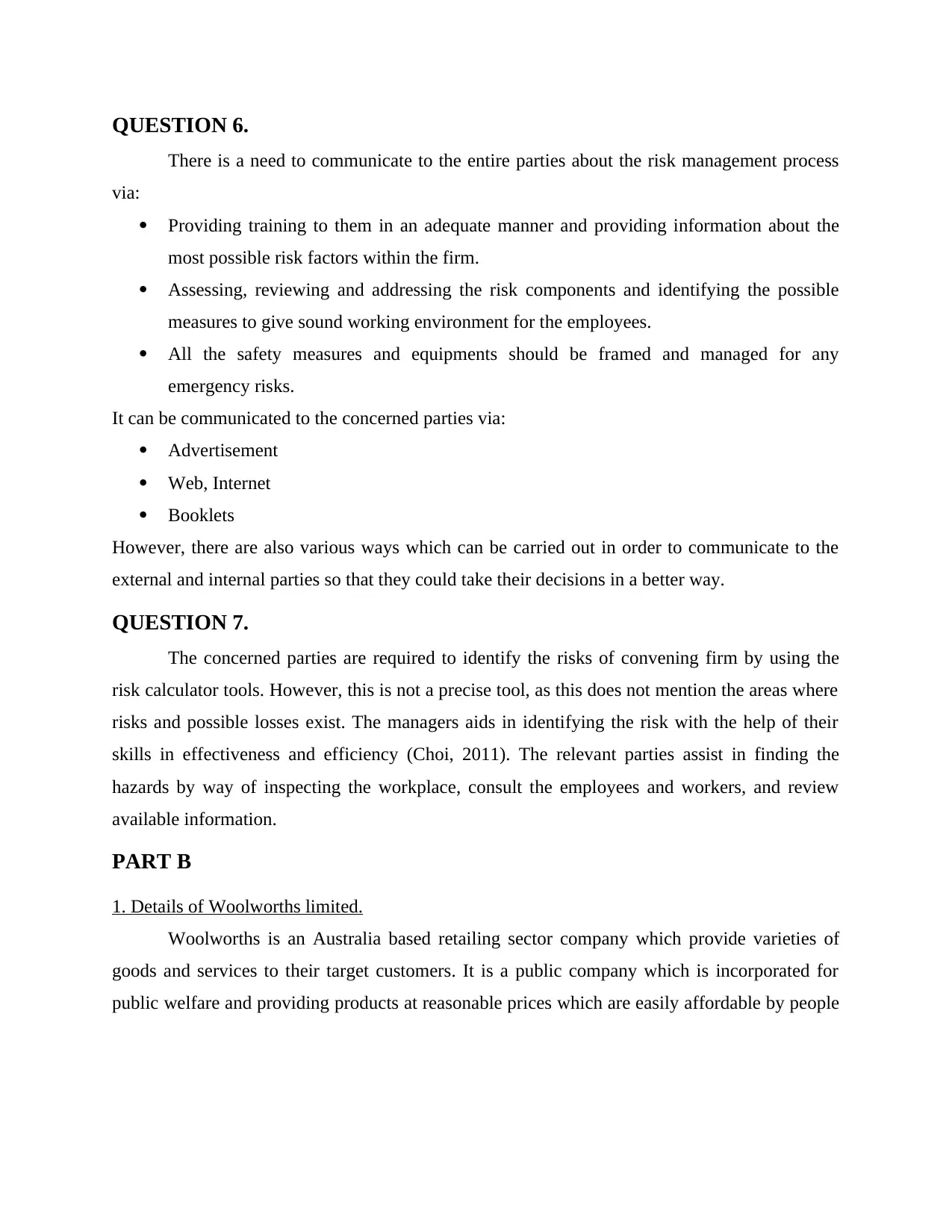
QUESTION 6.
There is a need to communicate to the entire parties about the risk management process
via:
Providing training to them in an adequate manner and providing information about the
most possible risk factors within the firm.
Assessing, reviewing and addressing the risk components and identifying the possible
measures to give sound working environment for the employees.
All the safety measures and equipments should be framed and managed for any
emergency risks.
It can be communicated to the concerned parties via:
Advertisement
Web, Internet
Booklets
However, there are also various ways which can be carried out in order to communicate to the
external and internal parties so that they could take their decisions in a better way.
QUESTION 7.
The concerned parties are required to identify the risks of convening firm by using the
risk calculator tools. However, this is not a precise tool, as this does not mention the areas where
risks and possible losses exist. The managers aids in identifying the risk with the help of their
skills in effectiveness and efficiency (Choi, 2011). The relevant parties assist in finding the
hazards by way of inspecting the workplace, consult the employees and workers, and review
available information.
PART B
1. Details of Woolworths limited.
Woolworths is an Australia based retailing sector company which provide varieties of
goods and services to their target customers. It is a public company which is incorporated for
public welfare and providing products at reasonable prices which are easily affordable by people
There is a need to communicate to the entire parties about the risk management process
via:
Providing training to them in an adequate manner and providing information about the
most possible risk factors within the firm.
Assessing, reviewing and addressing the risk components and identifying the possible
measures to give sound working environment for the employees.
All the safety measures and equipments should be framed and managed for any
emergency risks.
It can be communicated to the concerned parties via:
Advertisement
Web, Internet
Booklets
However, there are also various ways which can be carried out in order to communicate to the
external and internal parties so that they could take their decisions in a better way.
QUESTION 7.
The concerned parties are required to identify the risks of convening firm by using the
risk calculator tools. However, this is not a precise tool, as this does not mention the areas where
risks and possible losses exist. The managers aids in identifying the risk with the help of their
skills in effectiveness and efficiency (Choi, 2011). The relevant parties assist in finding the
hazards by way of inspecting the workplace, consult the employees and workers, and review
available information.
PART B
1. Details of Woolworths limited.
Woolworths is an Australia based retailing sector company which provide varieties of
goods and services to their target customers. It is a public company which is incorporated for
public welfare and providing products at reasonable prices which are easily affordable by people
⊘ This is a preview!⊘
Do you want full access?
Subscribe today to unlock all pages.

Trusted by 1+ million students worldwide
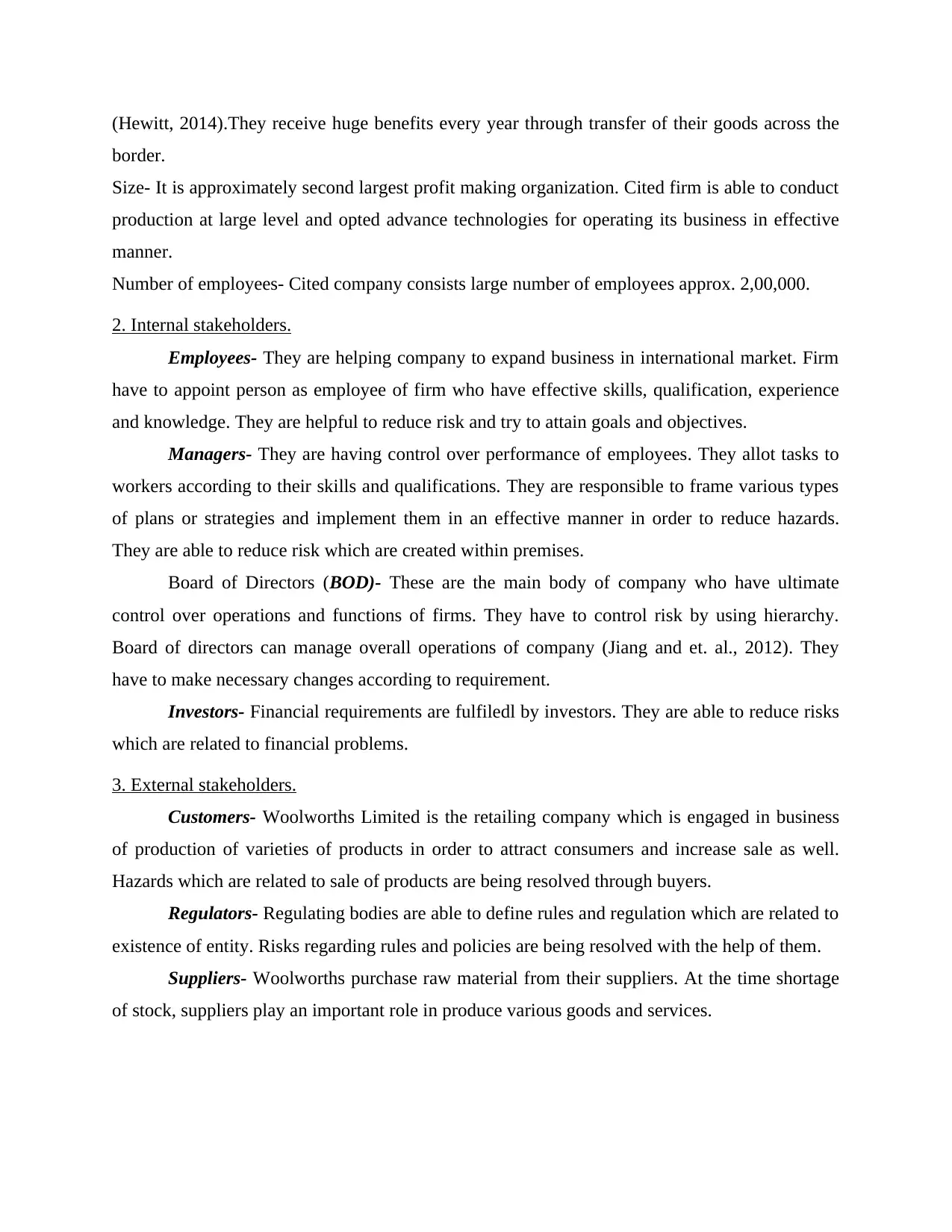
(Hewitt, 2014).They receive huge benefits every year through transfer of their goods across the
border.
Size- It is approximately second largest profit making organization. Cited firm is able to conduct
production at large level and opted advance technologies for operating its business in effective
manner.
Number of employees- Cited company consists large number of employees approx. 2,00,000.
2. Internal stakeholders.
Employees- They are helping company to expand business in international market. Firm
have to appoint person as employee of firm who have effective skills, qualification, experience
and knowledge. They are helpful to reduce risk and try to attain goals and objectives.
Managers- They are having control over performance of employees. They allot tasks to
workers according to their skills and qualifications. They are responsible to frame various types
of plans or strategies and implement them in an effective manner in order to reduce hazards.
They are able to reduce risk which are created within premises.
Board of Directors (BOD)- These are the main body of company who have ultimate
control over operations and functions of firms. They have to control risk by using hierarchy.
Board of directors can manage overall operations of company (Jiang and et. al., 2012). They
have to make necessary changes according to requirement.
Investors- Financial requirements are fulfiledl by investors. They are able to reduce risks
which are related to financial problems.
3. External stakeholders.
Customers- Woolworths Limited is the retailing company which is engaged in business
of production of varieties of products in order to attract consumers and increase sale as well.
Hazards which are related to sale of products are being resolved through buyers.
Regulators- Regulating bodies are able to define rules and regulation which are related to
existence of entity. Risks regarding rules and policies are being resolved with the help of them.
Suppliers- Woolworths purchase raw material from their suppliers. At the time shortage
of stock, suppliers play an important role in produce various goods and services.
border.
Size- It is approximately second largest profit making organization. Cited firm is able to conduct
production at large level and opted advance technologies for operating its business in effective
manner.
Number of employees- Cited company consists large number of employees approx. 2,00,000.
2. Internal stakeholders.
Employees- They are helping company to expand business in international market. Firm
have to appoint person as employee of firm who have effective skills, qualification, experience
and knowledge. They are helpful to reduce risk and try to attain goals and objectives.
Managers- They are having control over performance of employees. They allot tasks to
workers according to their skills and qualifications. They are responsible to frame various types
of plans or strategies and implement them in an effective manner in order to reduce hazards.
They are able to reduce risk which are created within premises.
Board of Directors (BOD)- These are the main body of company who have ultimate
control over operations and functions of firms. They have to control risk by using hierarchy.
Board of directors can manage overall operations of company (Jiang and et. al., 2012). They
have to make necessary changes according to requirement.
Investors- Financial requirements are fulfiledl by investors. They are able to reduce risks
which are related to financial problems.
3. External stakeholders.
Customers- Woolworths Limited is the retailing company which is engaged in business
of production of varieties of products in order to attract consumers and increase sale as well.
Hazards which are related to sale of products are being resolved through buyers.
Regulators- Regulating bodies are able to define rules and regulation which are related to
existence of entity. Risks regarding rules and policies are being resolved with the help of them.
Suppliers- Woolworths purchase raw material from their suppliers. At the time shortage
of stock, suppliers play an important role in produce various goods and services.
Paraphrase This Document
Need a fresh take? Get an instant paraphrase of this document with our AI Paraphraser
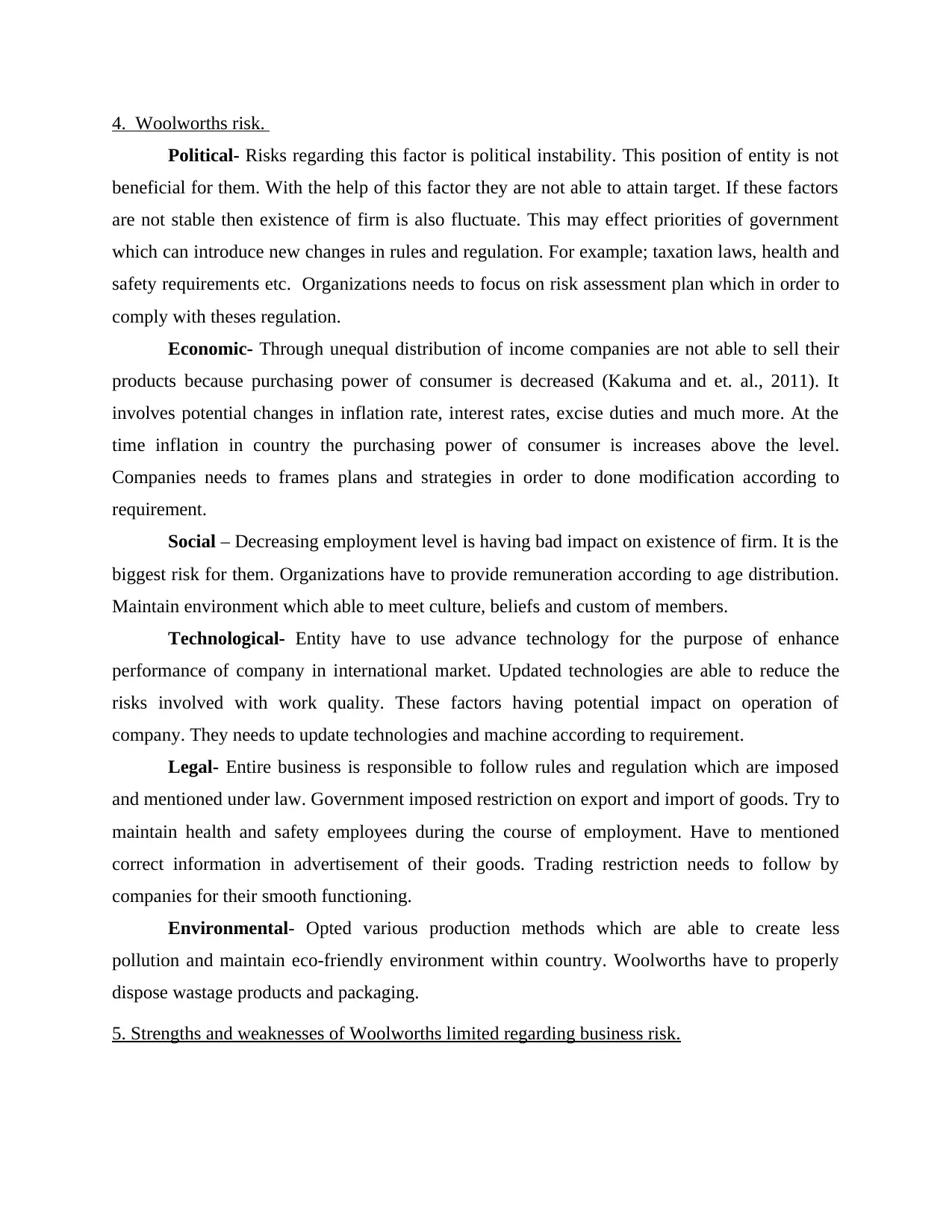
4. Woolworths risk.
Political- Risks regarding this factor is political instability. This position of entity is not
beneficial for them. With the help of this factor they are not able to attain target. If these factors
are not stable then existence of firm is also fluctuate. This may effect priorities of government
which can introduce new changes in rules and regulation. For example; taxation laws, health and
safety requirements etc. Organizations needs to focus on risk assessment plan which in order to
comply with theses regulation.
Economic- Through unequal distribution of income companies are not able to sell their
products because purchasing power of consumer is decreased (Kakuma and et. al., 2011). It
involves potential changes in inflation rate, interest rates, excise duties and much more. At the
time inflation in country the purchasing power of consumer is increases above the level.
Companies needs to frames plans and strategies in order to done modification according to
requirement.
Social – Decreasing employment level is having bad impact on existence of firm. It is the
biggest risk for them. Organizations have to provide remuneration according to age distribution.
Maintain environment which able to meet culture, beliefs and custom of members.
Technological- Entity have to use advance technology for the purpose of enhance
performance of company in international market. Updated technologies are able to reduce the
risks involved with work quality. These factors having potential impact on operation of
company. They needs to update technologies and machine according to requirement.
Legal- Entire business is responsible to follow rules and regulation which are imposed
and mentioned under law. Government imposed restriction on export and import of goods. Try to
maintain health and safety employees during the course of employment. Have to mentioned
correct information in advertisement of their goods. Trading restriction needs to follow by
companies for their smooth functioning.
Environmental- Opted various production methods which are able to create less
pollution and maintain eco-friendly environment within country. Woolworths have to properly
dispose wastage products and packaging.
5. Strengths and weaknesses of Woolworths limited regarding business risk.
Political- Risks regarding this factor is political instability. This position of entity is not
beneficial for them. With the help of this factor they are not able to attain target. If these factors
are not stable then existence of firm is also fluctuate. This may effect priorities of government
which can introduce new changes in rules and regulation. For example; taxation laws, health and
safety requirements etc. Organizations needs to focus on risk assessment plan which in order to
comply with theses regulation.
Economic- Through unequal distribution of income companies are not able to sell their
products because purchasing power of consumer is decreased (Kakuma and et. al., 2011). It
involves potential changes in inflation rate, interest rates, excise duties and much more. At the
time inflation in country the purchasing power of consumer is increases above the level.
Companies needs to frames plans and strategies in order to done modification according to
requirement.
Social – Decreasing employment level is having bad impact on existence of firm. It is the
biggest risk for them. Organizations have to provide remuneration according to age distribution.
Maintain environment which able to meet culture, beliefs and custom of members.
Technological- Entity have to use advance technology for the purpose of enhance
performance of company in international market. Updated technologies are able to reduce the
risks involved with work quality. These factors having potential impact on operation of
company. They needs to update technologies and machine according to requirement.
Legal- Entire business is responsible to follow rules and regulation which are imposed
and mentioned under law. Government imposed restriction on export and import of goods. Try to
maintain health and safety employees during the course of employment. Have to mentioned
correct information in advertisement of their goods. Trading restriction needs to follow by
companies for their smooth functioning.
Environmental- Opted various production methods which are able to create less
pollution and maintain eco-friendly environment within country. Woolworths have to properly
dispose wastage products and packaging.
5. Strengths and weaknesses of Woolworths limited regarding business risk.
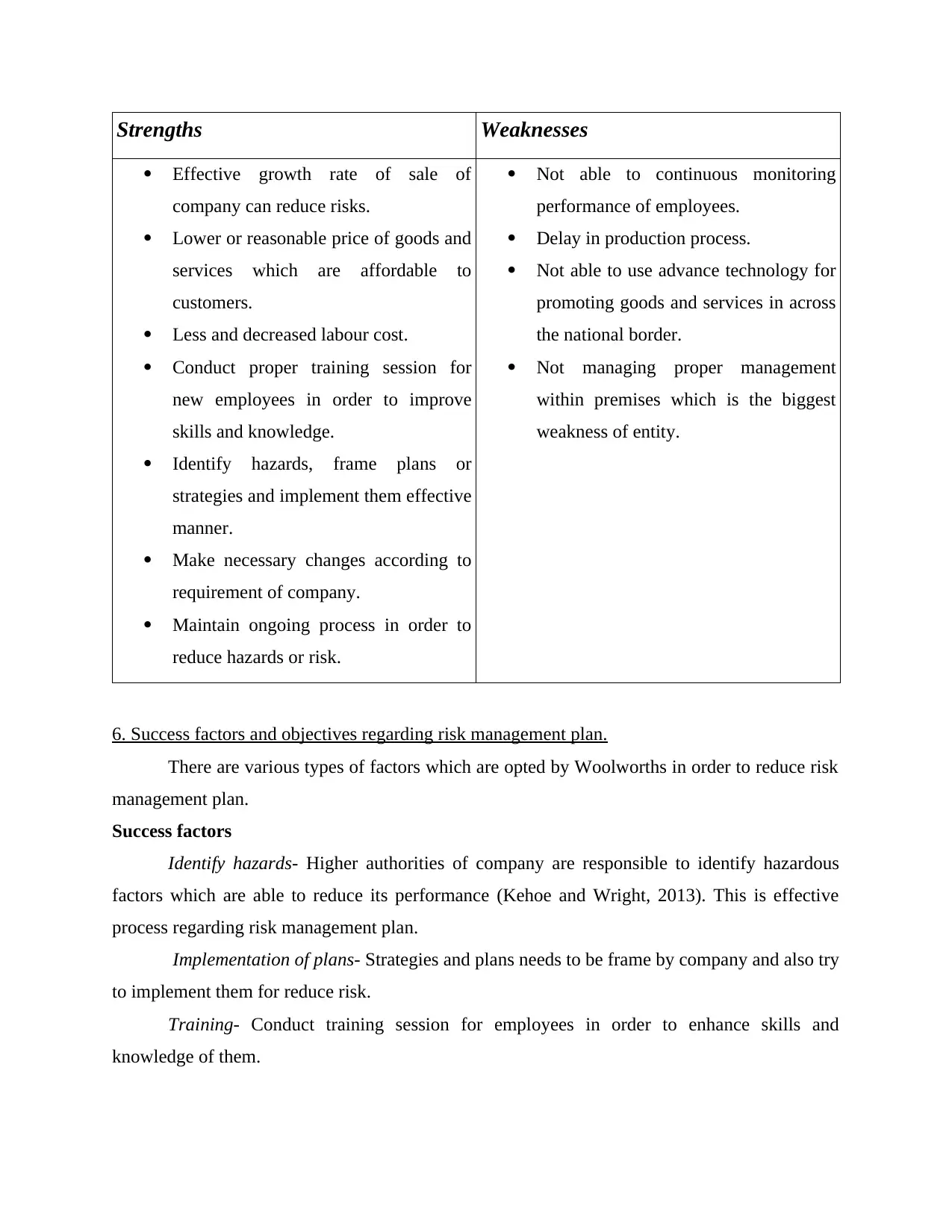
Strengths Weaknesses
Effective growth rate of sale of
company can reduce risks.
Lower or reasonable price of goods and
services which are affordable to
customers.
Less and decreased labour cost.
Conduct proper training session for
new employees in order to improve
skills and knowledge.
Identify hazards, frame plans or
strategies and implement them effective
manner.
Make necessary changes according to
requirement of company.
Maintain ongoing process in order to
reduce hazards or risk.
Not able to continuous monitoring
performance of employees.
Delay in production process.
Not able to use advance technology for
promoting goods and services in across
the national border.
Not managing proper management
within premises which is the biggest
weakness of entity.
6. Success factors and objectives regarding risk management plan.
There are various types of factors which are opted by Woolworths in order to reduce risk
management plan.
Success factors
Identify hazards- Higher authorities of company are responsible to identify hazardous
factors which are able to reduce its performance (Kehoe and Wright, 2013). This is effective
process regarding risk management plan.
Implementation of plans- Strategies and plans needs to be frame by company and also try
to implement them for reduce risk.
Training- Conduct training session for employees in order to enhance skills and
knowledge of them.
Effective growth rate of sale of
company can reduce risks.
Lower or reasonable price of goods and
services which are affordable to
customers.
Less and decreased labour cost.
Conduct proper training session for
new employees in order to improve
skills and knowledge.
Identify hazards, frame plans or
strategies and implement them effective
manner.
Make necessary changes according to
requirement of company.
Maintain ongoing process in order to
reduce hazards or risk.
Not able to continuous monitoring
performance of employees.
Delay in production process.
Not able to use advance technology for
promoting goods and services in across
the national border.
Not managing proper management
within premises which is the biggest
weakness of entity.
6. Success factors and objectives regarding risk management plan.
There are various types of factors which are opted by Woolworths in order to reduce risk
management plan.
Success factors
Identify hazards- Higher authorities of company are responsible to identify hazardous
factors which are able to reduce its performance (Kehoe and Wright, 2013). This is effective
process regarding risk management plan.
Implementation of plans- Strategies and plans needs to be frame by company and also try
to implement them for reduce risk.
Training- Conduct training session for employees in order to enhance skills and
knowledge of them.
⊘ This is a preview!⊘
Do you want full access?
Subscribe today to unlock all pages.

Trusted by 1+ million students worldwide
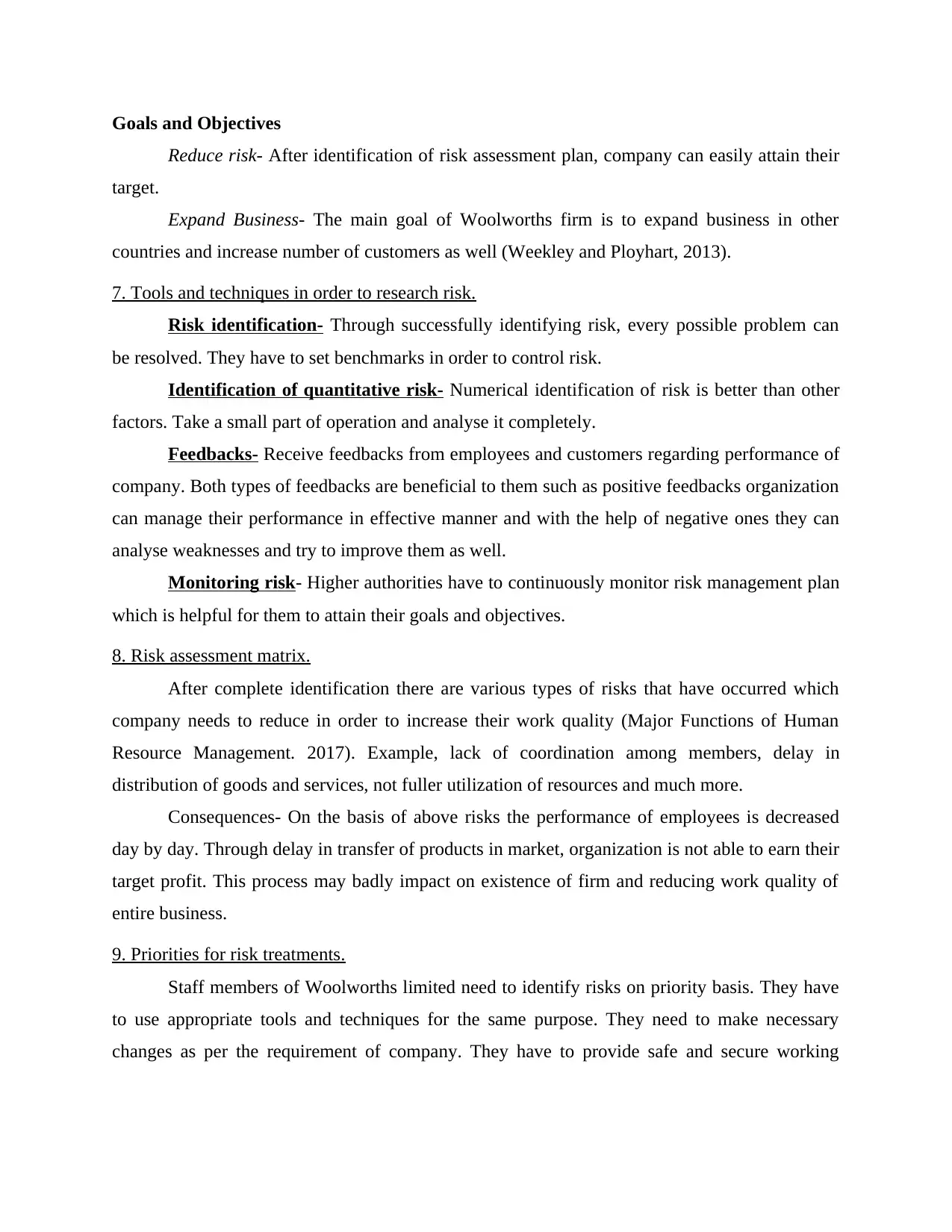
Goals and Objectives
Reduce risk- After identification of risk assessment plan, company can easily attain their
target.
Expand Business- The main goal of Woolworths firm is to expand business in other
countries and increase number of customers as well (Weekley and Ployhart, 2013).
7. Tools and techniques in order to research risk.
Risk identification- Through successfully identifying risk, every possible problem can
be resolved. They have to set benchmarks in order to control risk.
Identification of quantitative risk- Numerical identification of risk is better than other
factors. Take a small part of operation and analyse it completely.
Feedbacks- Receive feedbacks from employees and customers regarding performance of
company. Both types of feedbacks are beneficial to them such as positive feedbacks organization
can manage their performance in effective manner and with the help of negative ones they can
analyse weaknesses and try to improve them as well.
Monitoring risk- Higher authorities have to continuously monitor risk management plan
which is helpful for them to attain their goals and objectives.
8. Risk assessment matrix.
After complete identification there are various types of risks that have occurred which
company needs to reduce in order to increase their work quality (Major Functions of Human
Resource Management. 2017). Example, lack of coordination among members, delay in
distribution of goods and services, not fuller utilization of resources and much more.
Consequences- On the basis of above risks the performance of employees is decreased
day by day. Through delay in transfer of products in market, organization is not able to earn their
target profit. This process may badly impact on existence of firm and reducing work quality of
entire business.
9. Priorities for risk treatments.
Staff members of Woolworths limited need to identify risks on priority basis. They have
to use appropriate tools and techniques for the same purpose. They need to make necessary
changes as per the requirement of company. They have to provide safe and secure working
Reduce risk- After identification of risk assessment plan, company can easily attain their
target.
Expand Business- The main goal of Woolworths firm is to expand business in other
countries and increase number of customers as well (Weekley and Ployhart, 2013).
7. Tools and techniques in order to research risk.
Risk identification- Through successfully identifying risk, every possible problem can
be resolved. They have to set benchmarks in order to control risk.
Identification of quantitative risk- Numerical identification of risk is better than other
factors. Take a small part of operation and analyse it completely.
Feedbacks- Receive feedbacks from employees and customers regarding performance of
company. Both types of feedbacks are beneficial to them such as positive feedbacks organization
can manage their performance in effective manner and with the help of negative ones they can
analyse weaknesses and try to improve them as well.
Monitoring risk- Higher authorities have to continuously monitor risk management plan
which is helpful for them to attain their goals and objectives.
8. Risk assessment matrix.
After complete identification there are various types of risks that have occurred which
company needs to reduce in order to increase their work quality (Major Functions of Human
Resource Management. 2017). Example, lack of coordination among members, delay in
distribution of goods and services, not fuller utilization of resources and much more.
Consequences- On the basis of above risks the performance of employees is decreased
day by day. Through delay in transfer of products in market, organization is not able to earn their
target profit. This process may badly impact on existence of firm and reducing work quality of
entire business.
9. Priorities for risk treatments.
Staff members of Woolworths limited need to identify risks on priority basis. They have
to use appropriate tools and techniques for the same purpose. They need to make necessary
changes as per the requirement of company. They have to provide safe and secure working
Paraphrase This Document
Need a fresh take? Get an instant paraphrase of this document with our AI Paraphraser
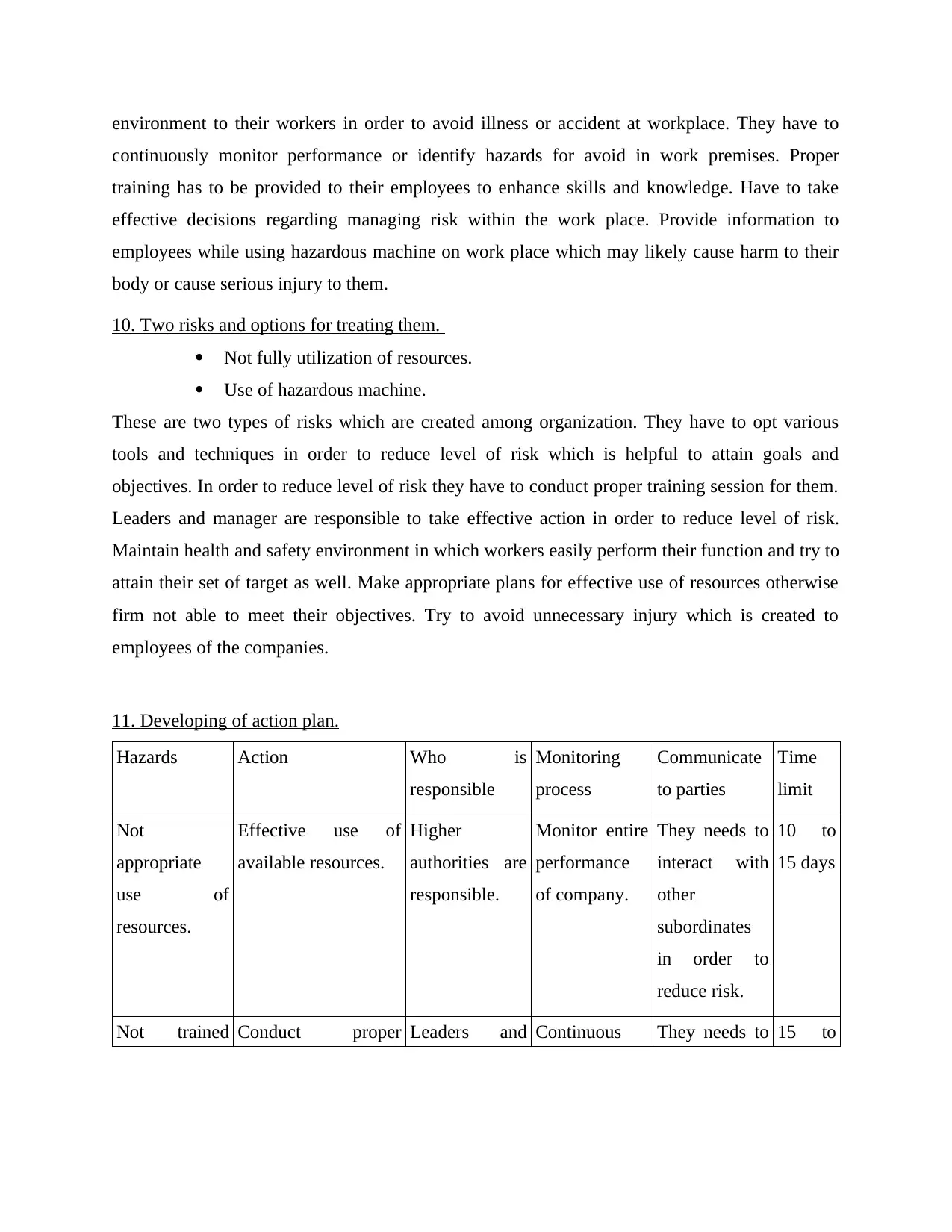
environment to their workers in order to avoid illness or accident at workplace. They have to
continuously monitor performance or identify hazards for avoid in work premises. Proper
training has to be provided to their employees to enhance skills and knowledge. Have to take
effective decisions regarding managing risk within the work place. Provide information to
employees while using hazardous machine on work place which may likely cause harm to their
body or cause serious injury to them.
10. Two risks and options for treating them.
Not fully utilization of resources.
Use of hazardous machine.
These are two types of risks which are created among organization. They have to opt various
tools and techniques in order to reduce level of risk which is helpful to attain goals and
objectives. In order to reduce level of risk they have to conduct proper training session for them.
Leaders and manager are responsible to take effective action in order to reduce level of risk.
Maintain health and safety environment in which workers easily perform their function and try to
attain their set of target as well. Make appropriate plans for effective use of resources otherwise
firm not able to meet their objectives. Try to avoid unnecessary injury which is created to
employees of the companies.
11. Developing of action plan.
Hazards Action Who is
responsible
Monitoring
process
Communicate
to parties
Time
limit
Not
appropriate
use of
resources.
Effective use of
available resources.
Higher
authorities are
responsible.
Monitor entire
performance
of company.
They needs to
interact with
other
subordinates
in order to
reduce risk.
10 to
15 days
Not trained Conduct proper Leaders and Continuous They needs to 15 to
continuously monitor performance or identify hazards for avoid in work premises. Proper
training has to be provided to their employees to enhance skills and knowledge. Have to take
effective decisions regarding managing risk within the work place. Provide information to
employees while using hazardous machine on work place which may likely cause harm to their
body or cause serious injury to them.
10. Two risks and options for treating them.
Not fully utilization of resources.
Use of hazardous machine.
These are two types of risks which are created among organization. They have to opt various
tools and techniques in order to reduce level of risk which is helpful to attain goals and
objectives. In order to reduce level of risk they have to conduct proper training session for them.
Leaders and manager are responsible to take effective action in order to reduce level of risk.
Maintain health and safety environment in which workers easily perform their function and try to
attain their set of target as well. Make appropriate plans for effective use of resources otherwise
firm not able to meet their objectives. Try to avoid unnecessary injury which is created to
employees of the companies.
11. Developing of action plan.
Hazards Action Who is
responsible
Monitoring
process
Communicate
to parties
Time
limit
Not
appropriate
use of
resources.
Effective use of
available resources.
Higher
authorities are
responsible.
Monitor entire
performance
of company.
They needs to
interact with
other
subordinates
in order to
reduce risk.
10 to
15 days
Not trained Conduct proper Leaders and Continuous They needs to 15 to

employees. training for workers
in order to enhance
their skills and
knowledge.
managers are
responsible to
provide
training to
employees.
monitor their
performance.
communicate
with other
members and
with
employees as
well.
20
days.
Not maintain
health and
safety within
premises.
Members have to
educate employees in
order to follow rules
and regulation which
is mentioned under
act.
Entire
members are
responsible for
the same.
Needs to
comply with
laws.
Communicate
with
employees and
provide proper
information to
them.
5 to 10
days
12. Documentation required.
Documentation is the process which is able to ensure the identified risks and try to
control them as well. It is helpful for managing hazards which reduces their performance. It is
record keeping process which helps authorities to take a view in future time and collect things as
an evidence. This process will help company in future time.
13. Implement and monitor plan.
Higher authorities have to frame plans and strategies in order to reduce risks for
company. They have to implement them as per the requirement of company which is helpful to
attain their set of target and objectives as well. Leaders and managers are responsible to
continuously monitor plans and strategies which meets their set of objectives. Take a view of
performance of employees and try to provide proper training to them.
14. Risk management process.
Risk management process depends upon the risk analysis and planning the activities. A
good management plan can be useful only when the risks are properly accessed. The main
objective of the risk management plan is achieved through critical evaluation of it. Every step is
in order to enhance
their skills and
knowledge.
managers are
responsible to
provide
training to
employees.
monitor their
performance.
communicate
with other
members and
with
employees as
well.
20
days.
Not maintain
health and
safety within
premises.
Members have to
educate employees in
order to follow rules
and regulation which
is mentioned under
act.
Entire
members are
responsible for
the same.
Needs to
comply with
laws.
Communicate
with
employees and
provide proper
information to
them.
5 to 10
days
12. Documentation required.
Documentation is the process which is able to ensure the identified risks and try to
control them as well. It is helpful for managing hazards which reduces their performance. It is
record keeping process which helps authorities to take a view in future time and collect things as
an evidence. This process will help company in future time.
13. Implement and monitor plan.
Higher authorities have to frame plans and strategies in order to reduce risks for
company. They have to implement them as per the requirement of company which is helpful to
attain their set of target and objectives as well. Leaders and managers are responsible to
continuously monitor plans and strategies which meets their set of objectives. Take a view of
performance of employees and try to provide proper training to them.
14. Risk management process.
Risk management process depends upon the risk analysis and planning the activities. A
good management plan can be useful only when the risks are properly accessed. The main
objective of the risk management plan is achieved through critical evaluation of it. Every step is
⊘ This is a preview!⊘
Do you want full access?
Subscribe today to unlock all pages.

Trusted by 1+ million students worldwide
1 out of 15
Related Documents
Your All-in-One AI-Powered Toolkit for Academic Success.
+13062052269
info@desklib.com
Available 24*7 on WhatsApp / Email
![[object Object]](/_next/static/media/star-bottom.7253800d.svg)
Unlock your academic potential
Copyright © 2020–2025 A2Z Services. All Rights Reserved. Developed and managed by ZUCOL.





